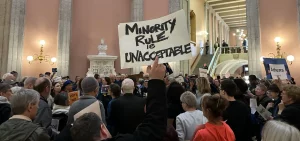News
The cost for Ohio’s August special election to decide the 60% voter approval amendment goes up
< < Back to ?p=301341COLUMBUS, Ohio (Statehouse News Bureau) — The cost of the August special election in which voters defeated an amendment to make it harder to change Ohio’s constitution has increased to $18 million.

Lawmakers on the state controlling board approved the secretary of state’s request for $2 million from chief financial officer Leslie Piatt, who noted boards of elections worked hard to recruit poll workers.
“There were some counties that increased – and probably very, very needed – increased their salaries, increased the poll worker pay,” Piatt told the panel on Monday. “We saw a large number of temporary workers compared to the last election.”
The request had been a late addition to the Controlling Board’s agenda. Reps. Jay Edwards (R-Nelsonville) and Bride Rose Sweeney (D-Cleveland) asked why the request wasn’t saved till next month’s meeting.
“We are advocating for the counties to receive their payment as soon as possible. [The] Nov. 7 election’s in a week. And while they will not have the checks in hand, maybe they will, with luck,” Piatt said. “But it was very important to us to make sure that the counties knew that we were going to get the payments out as soon as possible.”
This approval brings the cost of the election to decide August’s Issue 1 – to require 60% voter approval for future amendments – to $18 million. That’s more than LaRose’s initial forecast of the total tab.
“I’ve estimated for the General Assembly that it’s somewhere between $10 and $15 million. That is what it would take to run an additional election,” LaRose said to reporters at a press conference in March.
The state budget passed this summer included $16 million for the Aug. 8 election.
In May, Republican lawmakers had voted to put the amendment for the higher voter threshold before voters in August. That vote went forward though most August special elections were banned in a Republican-backed law passed last year because of high cost and low turnout. Some GOP lawmakers, including LaRose, had said putting the issue before voters in August was about blocking an amendment on reproductive rights and abortion access. That’s on the November ballot as Issue 1.
August’s Issue 1, the sole question on that statewide ballot, failed 57%-43%. Just over 39% of registered Ohio voters cast ballots.

